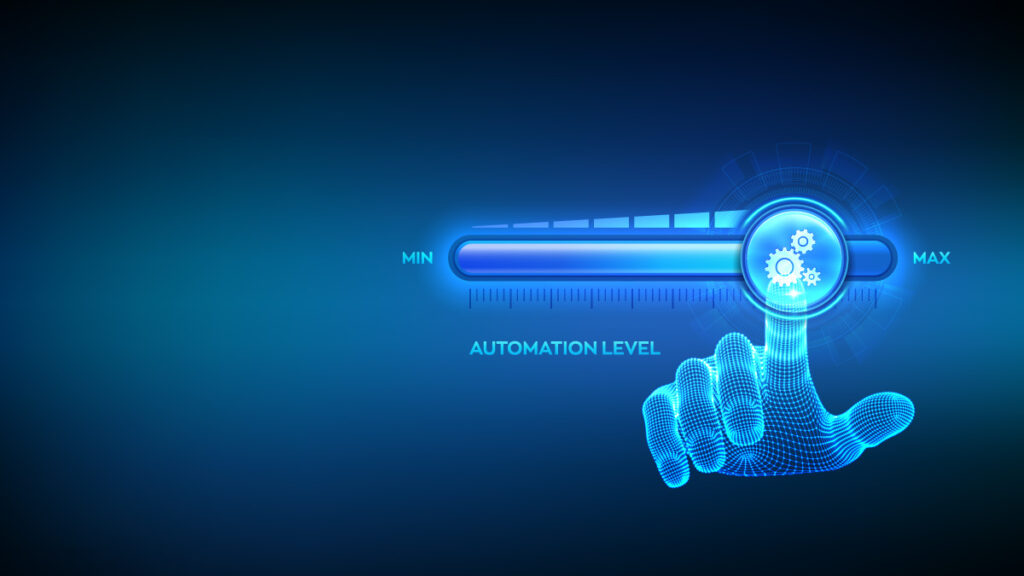Is warehouse optimization software only reasonable for highly automated warehouses? Not at all! Many warehouses rely on mainly labor dependent operations while others work with highly automated processes. In the end they all provide crucial functions within their supply chain network with more or less flexibility vs. more or less operating costs. But with constantly increasing space and personnel cost, labor shortage, and growing processing complexity, warehouse operations are more than ever under pressure to stay competitive. That’s why they need to optimize their processes with intelligent software solutions – regardless of the warehouse automation level.
A fully software-supported decision-making process in a labor dependent operation is different from one in a highly automated warehouse. But utilizing intelligent software to support decision-making processes like shift planning, demand forecasting, resource allocation or scheduling maintenance, is sensible in any warehouse.
Low automation
Labor dependent operations with entry level technologies traditionally operate mainly by on-the-go decision making. Day-to-day operations usually run through paperwork, shift planning is done using spreadsheets and making phone calls. However, this approach is prone to error and gets more cumbersome the more the operation grows.
Holistic resource planning
At a low automation level, a holistic resource planning solution delivers substantial advantages. It saves so much time to create a cost- and demand-based shift plan by the click of a button and having the best-fit operators automatically allocated to process steps. Planners do not need to know all information like competences or time preferences by heart, because they are saved in the system and considered in the planning process. Trainings are managed in the same system and the responsible team leaders get a reminder if any certificate needs renewal. Additionally, an app facilitates communication with operators: if something unexpected happens and a shift is suddenly understaffed, planners can send a notification via the app and employees can apply for this position online.
Live operational adjustments
Another characteristic of low automation warehouses is, that often team members decide how to process the work within the facility. Thus, it may not be apparent when and where bottlenecks or overcapacities occur. An intelligent software solution helps to detect bottlenecks online. It even suggests action alternatives, e. g. moving operators from one area to another or ending a shift earlier. Planned, current, and ideal performances and costs are evaluated across all processes to identify potentials for improvement.
Medium automation
The bigger the warehouse, the bigger operations get and that’s when they do not rely on labor only but add automation to support. Different material handling equipment and methods are used that assist task performance. These systems are dependent upon each other to run efficiently.
With increasing the warehouse automation level intelligent optimization software is integrated via an interface. Personnel as well as machines are considered when shift plans are created and also in bottleneck analysis. The software solution evaluates planned, actual, and ideal performance and costs across all processes to determine the best action alternatives. Measured performances and times are visualized at system, activity/process step, and employee levels in real time. Resources can be quickly reallocated to improve overall warehouse performance. An integrated CMMS (computerized maintenance management system) supports the structured and scheduled execution of required maintenance and repairs to increase asset life and best manage spare parts.
High automation
Highly automated warehouses have high-tech handling systems for the transport and storage of their goods. They even work with technologies like robots, image processing, etc. to automate as much as possible. These operations naturally reduced their number of employees so that they are not limited by the staff’s shifts and capacities.
In highly automated warehouses intelligent software solutions support the optimized planning of machine resources. Again, automatic bottleneck detection plays a major role to run operations efficiently. In this case, an integrated CMMS is essential. It supports work order prioritization and scheduling, preventive maintenance, spare parts handling, reporting, monitoring, and offers a mobile maintenance functionality for engineers.
One solution to drive operational efficiency with varying levels of automation
Each automation level has its advantages. What is important for each is to run as efficiently as possible at every hour of operation. That’s where an intelligent software solution is needed to help finding the potentials for optimization and realizing it. redPILOT offers a modular design that makes it possible to tailor the solution exactly to the operation’s needs. The holistic solution can also support you to understand, when it is reasonable to increase the level of automation in your warehouse.
Give us a call to discuss your optimization potential in detail or take part in our webinar to learn more about the the solution.

